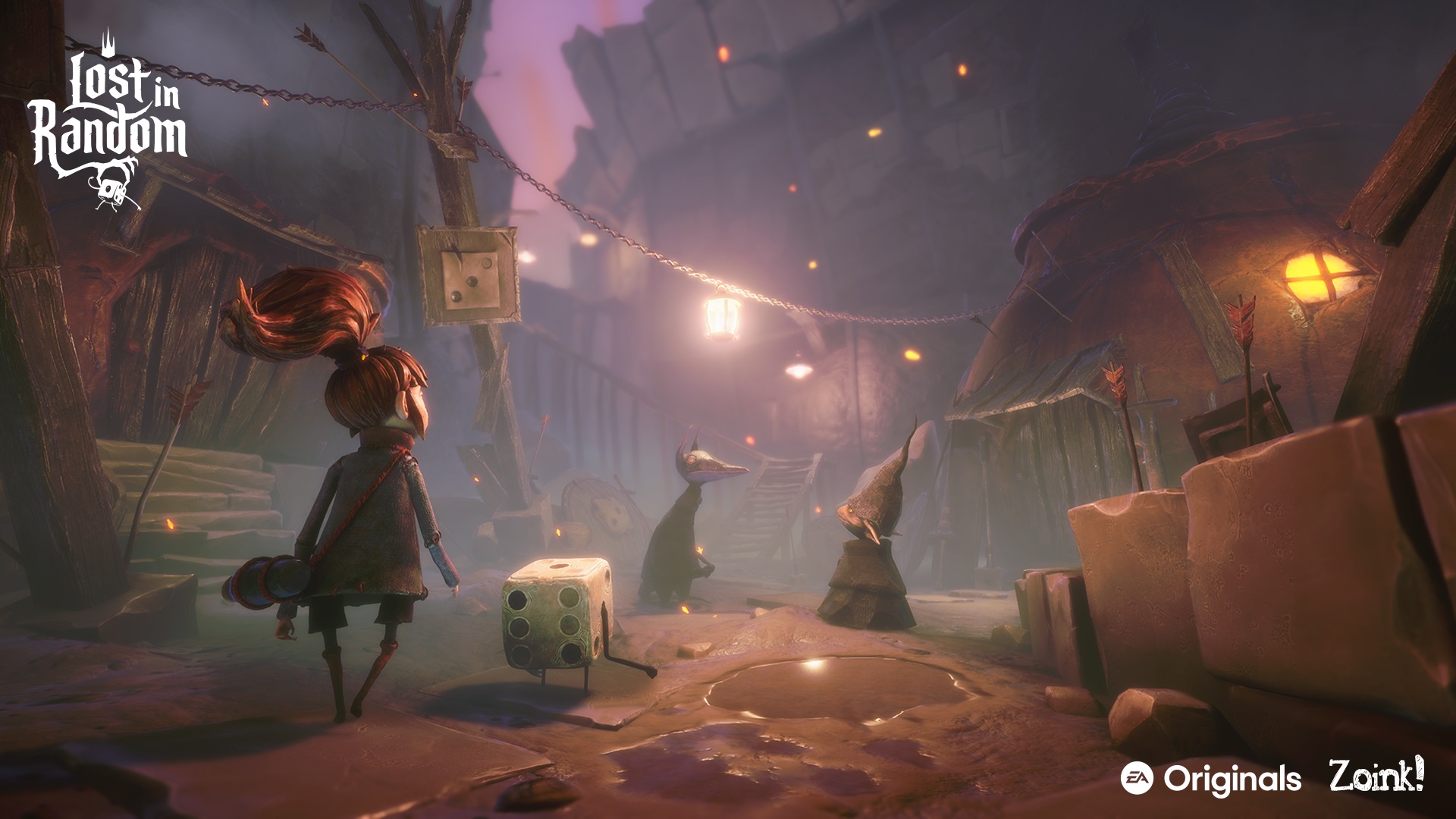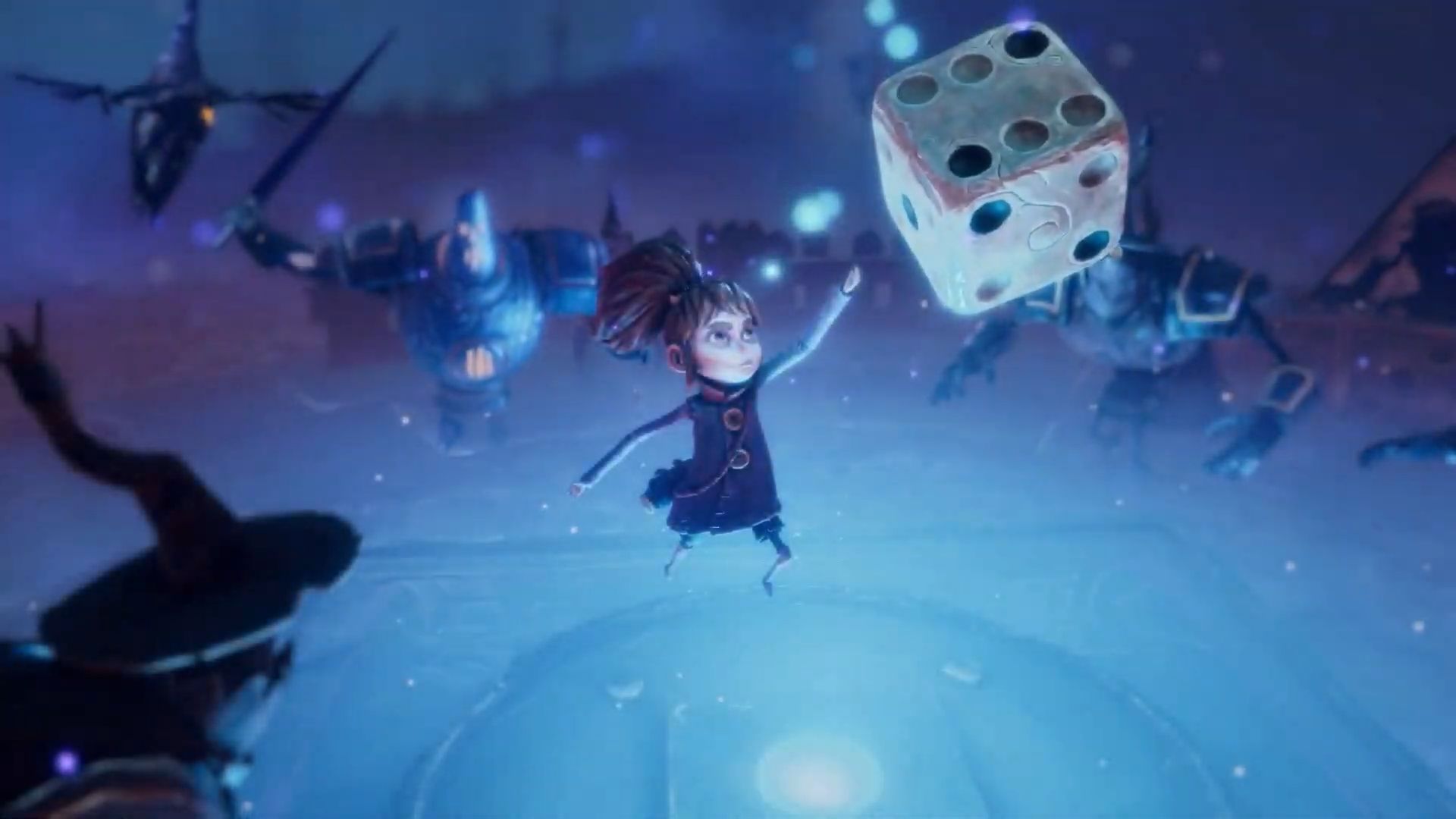Lost in Random is a card-powered action adventure with an offbeat sense of humor
We delve deep into Zoink Games' twisted yet hopeful tale

The two heroes of Lost in Random are Even, a young girl trying to rescue her older sister Odd, and Dicey, a living six-sided die who is supposed to be dead. Dice have the power to shape people's fate, and the same Evil Queen who stole away Odd has worked very hard to make sure she's the only one who holds that power. It sounds grim, and it is, but Lost and Random is always at least a little bit whimsical.
Lost in Random's world has a built-by-hand look, like you're guiding Even through a lovingly crafted puppeteering stage: "with the budget we got for Lost in Random, we could of course make close to AAA graphics, but instead of making something hyper-realistic, we really wanted to push this crafted style even more. We always wanted to do more stop-motion stuff, it's one of Klaus' original inspirations with Zoink [Games], and what we really wanted to keep pushing," creative director and lead writer Olov Redmalm tells me.
This attention to detail extends from the environment, to Even and Dicey, to even the smallest bit players on the periphery of their adventure, which takes me through Two-Town during my preview of Lost in Random's early hours. Gangly-limbed humans walk the streets of Two-Town along with hulking beastfolk, cloaked figures in masks, and reptiles with big pointy-toothed smiles.

Interactions with these side characters really shine through the oddball comedy chops of dialogue writer Ryan North. A frequent Zoink Games collaborator, North has also worked on The Incredible Squirrel Girl for Marvel, numerous Adventure Time comics, and his own long running Dinosaur Comics webcomic. The central task of rescuing your sister from an evil queen and her clockwork legions keep Lost in Random grounded in fairy tale horror, but the folks you meet along the way keep the story fun and dark, never dreary.
Fairy tales often bear lessons about the real world, and Lost in Random does the same. For instance, the inhabitants of Two-Town all have two personalities, with a roll of the dice at the start of each day determining which persona will be in the proverbial driver's seat. This is not how dissociative identity disorder, a real-life psychological diagnosis, works – but Zoink wants to use its own take on "split personalities" to drive home a message about self-acceptance.
"What I will say is that we absolutely talked about it, like, let's be careful about this because it's a real thing, and we don't want to make it a negative thing to have these different sides," Redmalm says. "Rather than making a mental illness something that you have to overcome and conquer and become better than, which I think is often wrong in culture, it's part of who we are – our neuroses and quirks. That's what I wanted the subtext of the story in Two-Town to be, without spoiling too much."
Psychonauts 2 very recently showed that games can treat mental illness as a source of inspiration without resorting to edgy vibes fraught by inaccurate generalizations. I haven't seen enough of Lost in Random to see how else it addresses real-life subject matter, but Zoink Games clearly wants its story to say something beyond the confines of Random.
Weekly digests, tales from the communities you love, and more
The hand you've been dealt

Even doesn't stand much of a chance on her own. The old slingshot she inherited from her sister does about as much damage to robotic knights as you'd expect. Thankfully, each enemy has a crystalline weak spot that will burst into a bunch of glowing blue bits when struck, and Dicey can hoover up those bits to charge their dice pips. Once he gets enough, Dicey will start pulling from a selection of magical cards he keeps stored in his, uh… head? Body? They're in there somewhere.
Anyway, the cards Dicey draws appear in the lower right corner of the screen, and you can play them one by one or wait until you have a full hand. Either way, you'll be whisked away to the "Dicemension," a shadowy realm where all your enemies are stopped in their tracks and you can take as much time as you need to reposition and decide on your next move.
If you've ever played Hearthstone, the basics will feel familiar: each card can be played to instantly manifest some change in the battlefield, and each has a resource cost that limits how many you can use in one go. Unlike Hearthstone, you're not focused on laying out a line of lackeys to do the fighting for you – you're equipping yourself with magic items that let you personally attack with swords, bows, bombs, and so on. Each item has limited uses, which means you'll return to the Dicemension several times throughout a fight to keep yourself kitted out.

You get more cards as you play but your deck can only ever hold 15 at a time, so savvy players will put some time into considering what works best and where. You aren't ever required to optimize your deck building strategy if you just prefer to throw in a bunch of heavy-hitting weapons and go to town, but you will feel like a smarty pants if you come up with a particularly good bit of card synergy.
Head of development Klaus Lyngeled offers a teaser for a high-level strategy that combines several cards – including a creature whose shrieks shatter those crystalline spots I mentioned before – for a devastating effect. "The cool thing about it is you can put the screaming creature here, then you can put a cannon over here that keeps shooting at the screaming creature, so that way you create this little machine that does it all the time. And then you can have another card that says when an enemy's crystal is shattered, they get hurt. So if you put those three together, you've suddenly created a machine that actually kills the enemies really quickly by itself."
Just one roll of the dice

Lost in Random is a self-contained tale, but its world is vast, and sketched in with just the right ratio of detail to blank spaces. Yes, Zoink is thinking about a sequel. "For this one it really felt like we were trying to create a universe that we could build more on," Lyngeled says. "I'm a big fan of old games like Oddworld, and how they created a world, and I think this game could be that. Or that this could be that world we build multiple games on, and board games. I obviously have really high hopes for the first game to do well. I think we're off to a good start. And if it goes well, I definitely want to see if we can do more things with it."
Redmalm adds that Zoink amassed "a lot of ideas" over the three or four years it has spent on Lost in Random, with many moments where the studio decided "OK, we'll save that for the second game." He's cautious not to spoil any potential specifics about what future Lost in Random games may entail, but Lyngeled seems so excited by their ideas he can't help but tease out one potential future.
"It's cool that you have the dice who's six-sided, but what if you have a character who has a 20-sided dice?" he says. "What if they have to fight each other? What if there are multiple dice wielders you have to meet, it could be almost like a Pokemon kind of setting, you know?"
As someone with a dice collection that is officially too large to fit into a single reasonably sized dice bag, I can confirm that I'm just as excited by the idea of a Pokemon-inspired dice battle game as Lyngeled. I'm also excited about the idea of a roguelike spinoff set in the same world, which one Zoink developer has already pitched internally, or a board game, which another employee has already taken some time away from the video game to conceptualize.
I can't say whether Lost in Random will have the success necessary to open up this world beyond the story of Even and Dicey with even more games and projects. I can say that, even after spending about five hours with the game, I'm excited to play more of Lost in Random when it arrives on Nintendo Switch, PC, PS4, PS5, Xbox One, and Xbox Series X and S on September 10.
If you want to roll some dice IRL before then, you should check out our guide to the best board games.
I got a BA in journalism from Central Michigan University - though the best education I received there was from CM Life, its student-run newspaper. Long before that, I started pursuing my degree in video games by bugging my older brother to let me play Zelda on the Super Nintendo. I've previously been a news intern for GameSpot, a news writer for CVG, and now I'm a staff writer here at GamesRadar.



